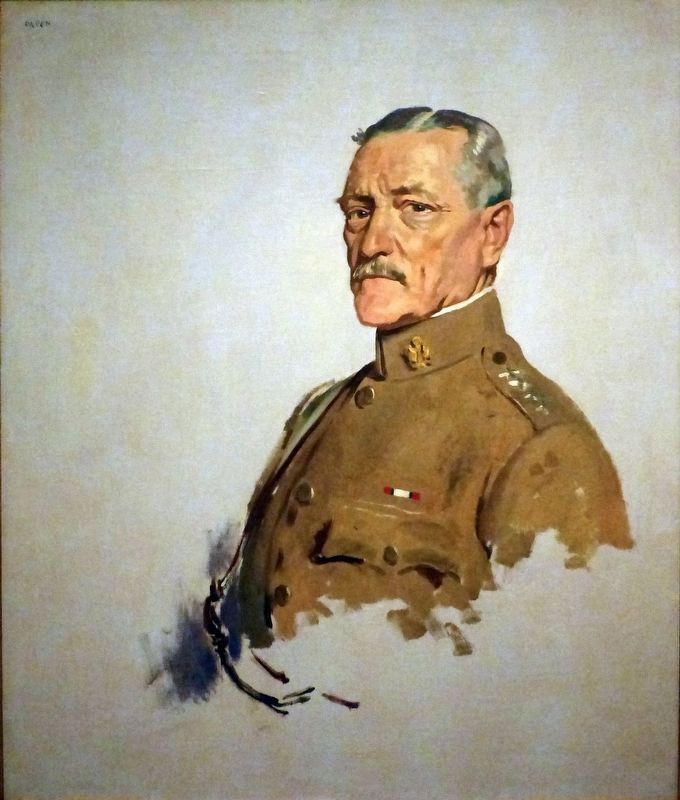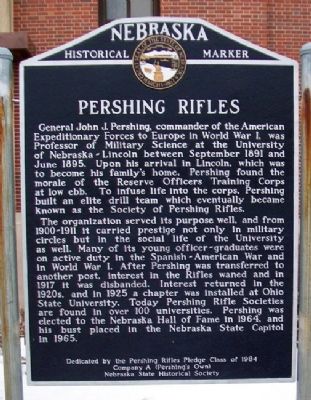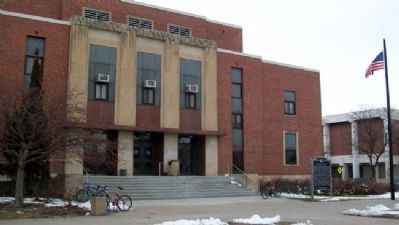Lincoln in Lancaster County, Nebraska — The American Midwest (Upper Plains)
Pershing Rifles
General John J. Pershing, commander of the American Expeditionary Forces to Europe in World War I, was Professor of Military Science at the University of Nebraska-Lincoln between September 1891 and June 1895. Upon his arrival in Lincoln, which was to become his family's home, Pershing found the morale of the Reserve Officers Training Corps at low ebb. To infuse life into the corps, Pershing built an elite drill team which eventually became known as the Society of Pershing Rifles.
The organization served its purpose well, and from 1900-1911 it carried prestige not only in military circles but in the social life of the University as well. Many of its young officer-graduates were on active duty in the Spanish-American War and in World War I. After Pershing was transferred to another post, interest in the Rifles waned and in 1917 it was disbanded. Interest returned in the 1920s, and in 1925 a chapter was installed at Ohio State University. Today Pershing Rifle Societies are found in over 100 universities. Pershing was elected to the Nebraska Hall of Fame in 1964, and his bust placed in the Nebraska State Capitol in 1965.
Erected by Pershing Rifles Pledge Class of 1984, Company A (Pershing's Own), and Nebraska State Historical Society. (Marker Number 290.)
Topics and series. This historical marker is listed in these topic lists: Education • Fraternal or Sororal Organizations • Patriots & Patriotism. In addition, it is included in the Nebraska State Historical Society series list. A significant historical month for this entry is June 1895.
Location. 40° 49.265′ N, 96° 42.093′ W. Marker is in Lincoln, Nebraska, in Lancaster County. Marker is at the intersection of Vine Street and 14th Street, on the right when traveling west on Vine Street. Marker is in front of the Military and Naval Science Building on the University of Nebraska-Lincoln west campus. Touch for map. Marker is in this post office area: Lincoln NE 68588, United States of America. Touch for directions.
Other nearby markers. At least 8 other markers are within walking distance of this marker. Mammuthus Columbi (about 300 feet away, measured in a direct line); Mueller Tower at University of Nebraska-Lincoln (about 400 feet away); The Lewis-Syford House (approx. 0.2 miles away); "America's Mission" (approx. ¼ mile away); Osborne Athletic Complex (approx. ¼ mile away); The University of Nebraska (approx. 0.3 miles away); RHO Chapter House (approx. 0.3 miles away); The Nebraska State Historical Society (approx. 0.3 miles away). Touch for a list and map of all markers in Lincoln.
Regarding Pershing Rifles. The contributor is a proud retired P/R MSgt from The Ohio State University.
Also see . . .
1. National Society of Pershing Rifles. (Submitted on April 12, 2012, by William Fischer, Jr. of Scranton, Pennsylvania.)
2. Pershing Memorial Museum and Leadership Archives. (Submitted on April 12, 2012, by William Fischer, Jr. of Scranton, Pennsylvania.)

Photographed By Allen C. Browne, November 29, 2015
3. John J. Pershing
This c. 1919 portrait of John J. Pershing by Sir William Orpen hangs in the National Portrait Gallery in Washington, DC.
“Shortly after the United States entered World War I in 1917, General John J. ‘Black jack’ Pershing (a nickname derived from his command of black troops in the Tenth Cavalry) took command of the American Expeditionary Forces going to Europe. His background and temperament fit with this country's emergence as a world power. Within little more than a year, he transported America's first massive twentieth-century army to the European front, where it contributed substantially to the German defeat in November 1918. Pershing deftly commanded the army and successfully held his soldiers separate from the French and British, who saw them as little more than replacements for their own massive casualties. Upon his return home, Pershing was designated ‘general of the armies’ - a title that no one had held since Ulysses Grant.” — National Portrait Gallery
“Shortly after the United States entered World War I in 1917, General John J. ‘Black jack’ Pershing (a nickname derived from his command of black troops in the Tenth Cavalry) took command of the American Expeditionary Forces going to Europe. His background and temperament fit with this country's emergence as a world power. Within little more than a year, he transported America's first massive twentieth-century army to the European front, where it contributed substantially to the German defeat in November 1918. Pershing deftly commanded the army and successfully held his soldiers separate from the French and British, who saw them as little more than replacements for their own massive casualties. Upon his return home, Pershing was designated ‘general of the armies’ - a title that no one had held since Ulysses Grant.” — National Portrait Gallery
Credits. This page was last revised on May 26, 2021. It was originally submitted on April 12, 2012, by William Fischer, Jr. of Scranton, Pennsylvania. This page has been viewed 786 times since then and 19 times this year. Photos: 1, 2. submitted on April 12, 2012, by William Fischer, Jr. of Scranton, Pennsylvania. 3. submitted on October 13, 2017, by Allen C. Browne of Silver Spring, Maryland.

